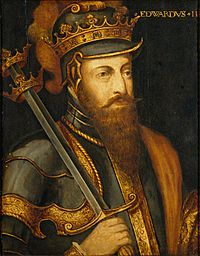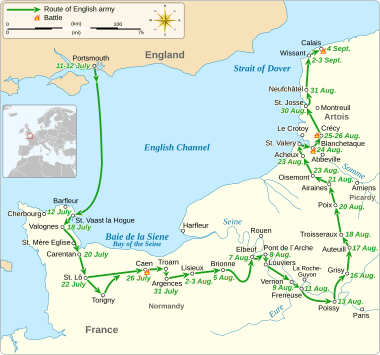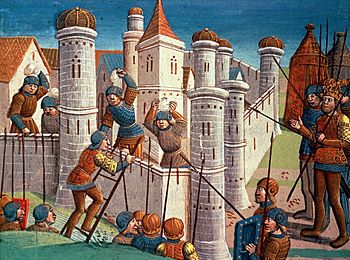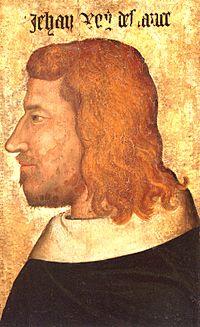Truce of Calais facts for kids
| Type | Time-limited truce |
|---|---|
| Context | Hundred Years' War |
| Drafted | September 1347 |
| Signed | 28 September 1347 |
| Location | Calais, France |
| Effective | 28 September 1347 |
| Expiration |
|
| Expiry | 1355 |
| Mediators | Two cardinals acting as emissaries for Pope Clement VI |
| Original signatories |
|
| Signatories | John II of France |
| Parties |
The Truce of Calais (French: Trêve de Calais) was a temporary peace agreement. It was made between King Edward III of England and King Philip VI of France. They signed it on September 28, 1347, near the city of Calais in France. Two important church leaders, called cardinals, helped them agree. These cardinals worked for Pope Clement VI.
The Hundred Years' War had started in 1337. In 1346, Edward III brought a large army to northern France. His army won a big battle against Philip VI's French army at the Battle of Crécy. After this victory, the English army surrounded the city of Calais. This was called the Siege of Calais. The city fell to the English after 11 months. Both England and France were very tired and had spent a lot of money on the war. So, the cardinals were able to help them agree to a truce. This truce was supposed to last until July 7, 1348.
King Edward wanted to make the truce last longer in May 1348. But King Philip wanted to keep fighting. However, a terrible sickness called the Black Death spread across Europe in 1348. It reached both England and France. This plague made it impossible for armies to fight. So, the truce was extended many times, in 1348, 1349, and 1350. During the truce, large armies did not fight big battles. But there were still small fights at sea and in areas like Gascony and Brittany.
Philip VI died on August 22, 1350. It was not clear if the truce was still valid because he had signed it personally. His son, John II, became the new king. John II led a large army in south-west France. After his army won, he agreed to extend the truce for another year, until September 10, 1352. But in January 1352, English adventurers captured a town called Guînes. This caused full-scale fighting to start again. The French army did not do well in these new fights.
Peace talks continued, but they did not work for a while. Then, on April 6, 1354, a new truce was agreed upon. They also made a plan for a lasting peace treaty, called the Treaty of Guînes. But King John II changed his mind later. He thought he could get a better deal if he fought more. So, the French planned big attacks for the 1355 fighting season. They ended the Treaty of Guînes early that year. Another extension to the Truce of Calais was agreed, but only until June 24. After that, it finally ended. The war started again in full force in October 1355.
In September 1356, the French army lost a major battle at Battle of Poitiers. King John II was captured by the English. In 1360, the fighting stopped for a short time with the Treaty of Brétigny. This treaty gave large parts of France to England. But in 1369, the big battles started again. The Hundred Years' War did not end until 1453. By then, England had lost almost all its land in France, except for Calais. Calais was finally lost in 1558.
Contents
Why the Truce Happened
For a long time, the English kings controlled land in France. By the 1330s, this land was mostly the region of Gascony. There were many disagreements between France and England about these lands. On May 24, 1337, the French king, Philip VI, said that the English king had lost his right to these lands. This event started the Hundred Years' War, which lasted for 116 years.
In 1340, the English king, Edward III, claimed he should be the King of France. He was the closest male relative to the previous French king. This claim allowed his allies to fight against France. In 1340, Edward fought Philip in northern France. They agreed to a five-year truce called the Truce of Esplechin. But this truce ended within a year. For several years, fighting was mostly in Brittany and Gascony.
In 1346, Edward gathered a huge army and fleet in England. It was the largest fleet England had ever built, with 747 ships. On July 12, they landed in Normandy, northern France. The English army had about 10,000 soldiers. They surprised the French and marched south. Edward's soldiers destroyed towns and took goods from the people. They attacked and looted Caen, an important city.
The English army then turned north. They got stuck in an area where the French had removed all food. They had to fight their way across the Somme River. Two days later, on August 26, 1346, the English won a huge victory at the Battle of Crécy. The English continued to destroy the land and burn towns. Edward decided to capture Calais. It was a perfect port for England, with a safe harbor and close to England. The English army arrived outside Calais on September 4 and began to surround it.
The Siege of Calais
Calais was a very strong city with thick walls. It was also surrounded by swamps, which made it hard to attack. The city had enough soldiers and food. It could also get more supplies by sea. Two cardinals from Pope Clement tried to talk to both kings, but neither king would listen. King Philip had sent most of his army home to save money. He thought Edward was done with his attacks.
Philip tried to gather his army again by October 1, but it was too fast. By October 1, only 3,000 soldiers had arrived. The French treasury could not pay them. So, Philip canceled all plans to attack on October 27 and sent his army away. People in France blamed each other for these problems. King Philip's son, Duke John, even argued with his father.
From November to February, Edward tried to break the walls of Calais with large machines called trebuchets and cannons. But he failed every time. During March and April, more than 1,000 tons of supplies reached Calais without any problems. Philip tried to gather his army again in late April. But the French still had trouble getting their army together. Taxes were hard to collect. Some French nobles even thought about joining Edward.
In April and May, there were small fights. The French tried to stop English supplies from reaching Flanders, but failed. The English tried to capture other towns, but also failed. In June, the French tried to attack the Flemings, but they were defeated at the Battle of Cassel.
In late April, the English built a fort at the entrance to Calais harbor. This allowed them to control who could enter the harbor. In May, June, and July, the French tried to send supply ships into Calais, but they failed. Even though England had money problems, they kept sending more soldiers to Calais. By 1347, they had 32,000 soldiers. More than 20,000 Flemings were also nearby. Over 24,000 sailors and 853 ships supported this force.
On July 17, Philip led the French army north. On July 27, the French army was about 6 miles from Calais. They had between 15,000 and 20,000 soldiers. This was much smaller than the English and Flemish armies combined. The English had built strong defenses. Philip saw that he could not attack the English position. So, he finally met with the Pope's representatives. They arranged talks, but after four days, nothing was agreed. On August 1, the soldiers inside Calais signaled that they were about to give up. That night, the French army left. On August 3, 1347, Calais surrendered. Edward sent all the French people out of the city. He then filled the town with English people and some Flemings.
After Calais fell, Edward sent many of his soldiers home. Philip also sent his French army home. Edward then sent small groups of soldiers to attack French land up to 30 miles away. Philip tried to call his army back, but he had serious problems. His treasury was empty, and he had to force people to pay taxes. The French soldiers did not want to fight anymore. Philip had to threaten nobles to make them join the army. Edward also had trouble raising money. The English also had two small losses. A large English raiding party was defeated by the French. Also, French raiders captured an English supply convoy going to Calais.
The Truce Agreement
Philip VI's Truce
The two cardinals from Pope Clement had been trying to stop the fighting since July 1346. They had not succeeded. But in September 1347, both sides were tired and had no money. So, the cardinals found people willing to listen. They agreed to a temporary stop to the fighting. The cardinals wrote down the detailed rules for the truce. These rules mostly favored the English. They allowed England to keep all the land they had taken in France and Scotland. The Flemings were also allowed to be independent from France. Philip was not allowed to punish French nobles who had fought against him. The truce was set to last until July 7, 1348. On September 28, the truce was officially signed. It was called the Truce of Calais because that is where it was agreed.
In November 1347, the French parliament, called the Estates General, complained about the truce. In May 1348, Edward suggested making the truce longer. But Philip refused. He was already getting his army ready for when the truce ended. However, in 1348, the Black Death spread across France. It reached Paris in August and London by November. This terrible plague killed about 45% of the people in both countries. It stopped all military plans. In late August, representatives from both kings met to talk about extending the truce. On November 13, it was extended until September 1, 1349. The next year, it was extended to May 1350. In June 1350, it was extended again to August 1351. During this time, large armies did not fight big battles. But there were still fights at sea and in Gascony and Brittany.
John II's Rule
Philip died on August 22, 1350. It was not clear if the truce was still valid since he had signed it personally. His son, John II, became the new king. John II did not say if the truce was still on. Instead, he led a large army. A French attack in Gascony in south-west France went well in 1351. The English could not stop them. While this was happening, talks to renew the truce started in Guînes on July 7. Guînes was about 8 miles south of Calais. The talks were slow.
Eventually, they agreed to change the original treaty. But the French delayed signing it. Once their army won in the south-west, King John agreed to the new truce. It was officially signed on September 11 and was to last for one year. As usual, the truce was not always followed. The fighting in the south-west hardly stopped.
In January 1352, English adventurers captured the important town of Guînes. This caused full-scale fighting to break out again. The French did not do well in these fights. They ran out of money and desire to fight. Their government stopped working well. The new pope, Innocent VI, encouraged peace talks. So, talks for a lasting peace treaty started in Guînes in early March 1353. But these talks failed. On May 8, the French ended the truce. They announced a call for all able-bodied men to join the army in Normandy. The negotiators met briefly in Paris on July 26. They extended the truce until November. But everyone knew that fighting would continue.
The Treaty of Guînes
The French government was falling apart. French nobles started fighting each other instead of the English. Charles of Navarre, a powerful person in France, even murdered a French leader. Navarre then boasted about it and talked to the English about becoming allies. Navarre and John officially made up in March 1354. The French government then became more open to peace with England.
Informal talks started again in Guînes in mid-March. They agreed that Edward would give up his claim to the French throne. In return, he would get French land. Edward agreed to this on March 30. Official talks started in early April. They quickly reached an agreement. The truce was extended for another year. They also agreed on the main points of a lasting peace. On April 6, 1354, representatives from both countries officially signed these points as the Treaty of Guînes.
The extension of the truce was announced right away. But the plan for a peace treaty was kept secret until October 1. The Pope would announce it at his palace in Avignon. At the same ceremony, English representatives would give up England's claim to John's throne. The French would officially give up control over several areas in south-west France to the English. Edward was very happy. The English parliament approved the treaty without even seeing it. John also approved the treaty, but some of his advisors were not happy.
The English followed the truce. But John of Armagnac, the French commander in the south-west, ignored his orders to keep the peace. His attacks did not work. We don't know exactly how much the French leaders knew about the treaty. But most of them were against its terms. In August, it was found that some of the men who negotiated the treaty were involved in the murder of Charles of Spain. At least three of John's closest advisors left his court. By early September, the French court was against the treaty. The date for the official ceremony in Avignon was canceled. No one knew when, or if, it would happen.
The Truce Ends
In November 1354, John took all of Navarre's lands. He surrounded towns that did not surrender. Talks to finish the treaty details in Avignon did not happen because French ambassadors did not show up. John decided that more fighting might help him get a better deal. The French planned many attacks for the 1355 fighting season.
French ambassadors arrived in Avignon in mid-January 1355. They rejected the previous agreement and tried to start new talks. The English and a cardinal pushed them to stick to the existing treaty. This disagreement lasted for a month. At the same time, the English tried to make an alliance with Navarre against France. By the end of February, it was clear that their official talks were useless. The groups left with a lot of anger. Their only success was a formal extension of the truce until June 24. It was clear that after that, both sides would fight a full-scale war. In April 1355, two papal representatives asked Edward to extend the Truce of Calais again. But he refused, and the agreement finally ended.
What Happened Next
The war started again in full force in October 1355. Both Edward and his son, Edward the Black Prince, fought in different parts of France. In September 1356, the French army was defeated by a smaller English force at the Battle of Poitiers. King John was captured. In 1360, the fighting stopped for a while with the Treaty of Brétigny. This treaty was similar to the Treaty of Guînes, but with slightly less good terms for the English. It gave large areas of France to England. In 1369, big battles started again. The Hundred Years' War did not end until 1453. By then, England had lost all its land in France except for Calais. Calais was finally lost after a siege in 1558.






